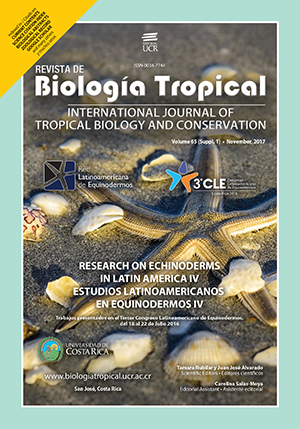Abstract
Morphometrics of echinoids in the Family Cassidulidae (Echinoidea: Cassiduloida).
Cassidulidae is the type family of the order Cassiduloida, and contains five genera whose morphology has complicated their taxonomic study: Australanthus, Cassidulus, Eurhodia, Paralampas, and Rhyncholampas. Many authors have applied traditional morphometric analysis (mainly length, width, and height) with varying success. We present the first approach with geometric morphometrics (three outlines: aboral, left, and posterior). Genera Eurhodia and Paralampas are more varied than the others. For future studies, we recommend larger samples, and the inclusion of size and qualitative characters such as the ambulacra and peristome. Rev. Biol. Trop. 65(Suppl. 1): S233-S243. Epub 2017 November 01.
References
Agassiz, A. (1863). List of the echinoderms sent to different institutions in Exchange for other specimens, with annotations. Bulletin Of The Museum Of Comparative Zoology, 1 (2), 17-28.
Agassiz, A. (1869). Preliminary report on the echini and starfishes dredged in deep water between Cuba And The Florida Reef. Por L. F. De Pourtalès. Bulletin Museum Of Comparative Zoölogy, 1 (9), 253-308.
Agassiz, L., & Desor, E. (1847). Catalogue raisonné des espèces, de genres, et des familles d’echinides. Parte 1. En Annales des Sciences Naturelles, 3 (7), 129-168.
Carter, B. D., & Beisel, T. H. (1987). “Cassidulus” trojanus belongs in the genus Eurhodia (Echinoidea) based upon new criteria. The paleontological society. Journal of Paleontology, 61, 5.
Ciampaglio, N. Ch., & D’Orazio, A. E. (2007). Heterochrony within the cassiduloid echinoids from the Castle Hayne limestone of southeastern North Carolina. Historical Biology, 19 (4), 301-313.
Duncan, P. M., & Sladen, W. P. (1882).The fossil Echinoidea from the Ranikiot Series of Nummulitic strata in western Sind. Palaeontologica Indica, 14th series, 1 (3), 21-100, pl. 5-20.
Kier, P. M. (1962). Revision of the cassiduloid echinoids. Smithsonian Miscellaneus Collections, 144 (3), 1-262.
Kier, P. M. (1967). Revision Of The Oligopygoid Echinoids. Smithsonian Miscellaneous Collections, 152 (2), 1-149.
Klingenberg, C. P. (2011). Morpho J: an integrate software package for geometric morphometrics. Molecular Ecology Resources, 11, 353-377.
Lamarck, J. B. (1801). Systême des animaux sans vertèbres. 1-349.
Martínez-Melo, A. (2008). Relación heterocrónica entre Rhyncholampas pacificus (A. Agassiz, 1863) y Cassidulus caribaearum Lamarck, 1801. Posgrado de Ciencias del Mar y Limnología, Universidad Nacional Autónoma de México, México.
MNHN. (2016). https://science.mnhn.fr/taxon/species/paralampas/rancureli
Mooi, R. (1990). Living cassiduloids (Echinodermata: Echinoidea): A key and annotated list. Proceedings of the Biological Society of Washington, 103, 63-85.
Mortensen, T. (1948). A monograph of the Echinoidea. IV. 1. Holectypoida, Cassiduloida. C. A. Rietzel, Copenhagen, Dinamarca.
Rohlf, F. J. (2000). Statistical power comparisons among alternative morphometric methods. American Journal of Physical Anthropology, 111, 463-478.
Rohlf, J. F. (2016a). TpsDig version 2.26. SUNY at Stony Brook.
Rohlf, J. F. (2016b). TpsUtil. Program version 1.58. SUNY at Stony Brook.
Sheets, H. D. (2016a). CoordGen 6f. NY: Canisus College. (Geometric morphometric software for the PC). Disponible en: www3. canisius. edu/~ sheets/morphsoft. html
Sheets, H. D. (2016b). MakeFan, a tool for drawing alignment ‘fans’ at equal angular spacing. Disponible en: www3. canisius. edu/~ sheets/morphsoft. html.
Smith, A. B., & Kroh, A. (2011).The echinoid directory. World wide web electronic publication. http://www.nhm.ac.uk/research-curation/projects/echinoid-directory/ index.
Suter, S. J. (1994a). Cladistic analysis of cassiduloid echinoids: trying to see the phylogeny for the trees. Zoological Journal of the Linnean Society, 53, 31-72.
Suter, S. J. (1994b). Cladistic analysis of the living cassiduloids (Echinoidea), and the effects of character ordering and succesive approximations weighting. Zoological Journal of the Linnean Society, 112, 363-387.
Suter, S. J. (1994c). Phylogenetic analices of cassiduloid echinoids (Echinodermata: Neognathostomata): Morphology, homoplasy and stratigraphic data. Universidad de Chicago, Estados Unidos de América.
Wilkinson, M., Suter, S. J., & Shires, V. L. (1996). The reduced cladistic consensus method and cassiduloid echinoid phylogeny. Historical biology, 12, 63-73.
Zachos, L. G., & Molineux, A. (2003). Eocene echinoids of Texas. Journal of paleontology, 77(3), 491-508.
Comments

This work is licensed under a Creative Commons Attribution 4.0 International License.
Copyright (c) 2017 Revista de Biología Tropical






